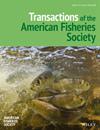Evaluating the effects of selective passage of migratory Westslope Cutthroat Trout on nonnative admixture
IF 1.4
3区 农林科学
Q2 FISHERIES
引用次数: 0
Abstract
Abstract Objective Hybridization with nonnative Rainbow Trout Oncorhynchus mykiss is a primary threat to the persistence of Westslope Cutthroat Trout O. clarkii lewisi . Managers concerned with conserving migratory populations of Westslope Cutthroat Trout in the presence of Rainbow Trout often face the predicament of tolerating the spread of hybridization, intentionally isolating Westslope Cutthroat Trout populations, or suppressing Rainbow Trout source populations. Methods Selective passage of migratory Westslope Cutthroat Trout above existing barriers is a management approach with the potential to limit hybridization, while minimizing the population impacts of barriers in populations with preexisting low levels of hybridization. We took a before‐after–control‐impact approach to evaluate a phenotype‐based selective passage management program for migratory Westslope Cutthroat Trout in the Jocko River, Montana. Result Of the 364 genotyped individuals selectively passed upstream of a barrier, 82% had a proportion of Rainbow Trout admixture < 0.01 and 98% had < 0.10. Over 14 years (2005–2019), there was no significant increase in hybridization at sites ( n = 12) upstream of the barrier, but metrics increased within some of our control (no barrier, n = 8) sites. This increase was greatest at a site just downstream from the barrier, suggesting that blocked fish might have spawned opportunistically in this adjacent tributary. Conclusion We demonstrate that phenotypic traits were useful in implementing a selective Westslope Cutthroat Trout passage program that allowed managers to promote the migratory life history without increasing nonnative admixture in this watershed.评价西坡切喉鳟鱼洄游对外来混和物选择性通过的影响
摘要目的与非本地虹鳟鱼Oncorhynchus mykiss杂交是西坡克氏切喉鳟鱼持续存在的主要威胁。在虹鳟鱼存在的情况下,关注保护西坡切喉鳟鱼迁徙种群的管理人员经常面临着容忍杂交传播、故意隔离西坡切喉鳟鱼种群或抑制虹鳟鱼源种群的困境。方法将西坡切喉鳟鱼在现有屏障上选择性通过是一种有可能限制杂交的管理方法,同时将屏障对先前存在低杂交水平的种群的影响降到最低。我们采用控制前-控制后-影响的方法来评估蒙大拿乔科河西坡切喉鳟鱼洄游的基于表型的选择性传代管理方案。结果364个基因型个体选择性通过屏障上游,82%的个体具有虹鳟鱼混合物的比例;0.01和98%有<0.10. 在过去的14年中(2005-2019年),在屏障上游的位点(n = 12)杂交没有显著增加,但在我们的一些对照位点(没有屏障,n = 8)杂交指标增加。这种增长在屏障下游的一个地方最大,这表明被阻塞的鱼可能是在邻近的支流中机会性地产卵的。我们证明了表型性状在实施选择性西坡切喉鳟鱼传代计划中是有用的,该计划允许管理者在不增加该流域外来混合的情况下促进迁徙生活史。
本文章由计算机程序翻译,如有差异,请以英文原文为准。
求助全文
约1分钟内获得全文
求助全文
来源期刊
CiteScore
2.90
自引率
7.10%
发文量
48
审稿时长
8-16 weeks
期刊介绍:
Transactions of the American Fisheries Society is a highly regarded international journal of fisheries science that has been published continuously since 1872. It features results of basic and applied research in genetics, physiology, biology, ecology, population dynamics, economics, health, culture, and other topics germane to marine and freshwater finfish and shellfish and their respective fisheries and environments.

 求助内容:
求助内容: 应助结果提醒方式:
应助结果提醒方式:


